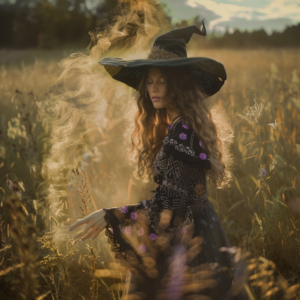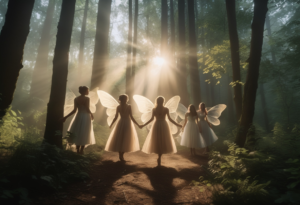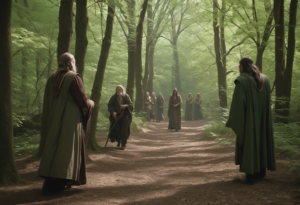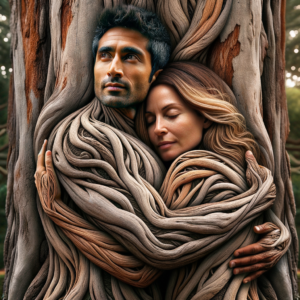
Introduction: Witches have captivated human imagination for centuries, evoking images of magical powers, broomsticks, and bubbling cauldrons. But beyond the realm of folklore and fantasy lies a rich tapestry of real history, spanning cultures, continents, and millennia. In this article, we embark on a journey through the true story of witches, from their ancient origins to their enduring legacy in modern times.
Ancient Origins: The history of witches traces back to ancient civilizations, where spiritual practices and magical beliefs were deeply intertwined with everyday life. In ancient Mesopotamia, Sumerian priestesses known as “enkis” served as intermediaries between the gods and humanity, practicing divination and healing rituals. Similarly, in ancient Egypt, priestesses of the goddess Isis performed magical spells and incantations to invoke divine blessings and protection.
The classical world of Greece and Rome also had its share of magical practitioners, including the legendary sorceress Medea and the witches of Thessaly. These women were believed to possess supernatural powers to manipulate the forces of nature, cast spells, and communicate with spirits. However, they were often feared and marginalized by mainstream society, viewed as threats to the established order.
Medieval Witch Hunts: The perception of witches took a dark turn during the medieval period, fueled by religious fervor, social upheaval, and superstition. In Christian Europe, the Church demonized witches as servants of the devil, blaming them for natural disasters, illnesses, and misfortunes. The infamous witch hunts of the 15th to 17th centuries led to the persecution and execution of thousands of alleged witches, mostly women but also men and children, across Europe and colonial America.
 The witch hunts were characterized by hysteria, mass paranoia, and gross miscarriages of justice. Accusations of witchcraft were often based on hearsay, superstition, and prejudice, with torture used to extract confessions and trials conducted without due process. The Malleus Maleficarum, a 15th-century witch-hunting manual, codified the beliefs and methods used to identify, prosecute, and punish witches, perpetuating fear and persecution for centuries.
The witch hunts were characterized by hysteria, mass paranoia, and gross miscarriages of justice. Accusations of witchcraft were often based on hearsay, superstition, and prejudice, with torture used to extract confessions and trials conducted without due process. The Malleus Maleficarum, a 15th-century witch-hunting manual, codified the beliefs and methods used to identify, prosecute, and punish witches, perpetuating fear and persecution for centuries.
Witch Trials and Witchcraft Trials: Witch trials varied in severity and scope across different regions and periods, but they shared common elements of witchcraft accusations, trials, and punishments. In England, the Witchcraft Act of 1563 made it a crime to practice witchcraft, punishable by death, although actual executions were relatively rare compared to continental Europe. The Salem witch trials of 1692 in Massachusetts are among the most infamous examples of witch hysteria in colonial America, resulting in the execution of 20 people accused of witchcraft.
Witch hunts also occurred in other parts of the world, including Africa, Asia, and the Middle East, where indigenous spiritual practices were demonized by colonial powers and missionary zeal. The persecution of witches persisted into the early modern period, fueled by fear, ignorance, and the desire for power and control. It wasn’t until the Enlightenment and the rise of rationalism that attitudes towards witchcraft began to shift, paving the way for the decline of witch trials and the emergence of modern skepticism.
Modern Witchcraft Revival: The 20th century witnessed a revival of interest in witchcraft and magic, fueled by movements such as Romanticism, nationalism, and the search for spiritual alternatives to mainstream religion. Figures like Margaret Murray and Gerald Gardner played pivotal roles in shaping the modern perception of witchcraft as a nature-based, polytheistic religion with roots in ancient paganism.
Gardner, often referred to as the “Father of Modern Witchcraft,” founded the Wiccan tradition in the mid-20th century, drawing on elements of ceremonial magic, folk witchcraft, and Freemasonry. Wicca emphasizes reverence for nature, ritual magic, and the worship of a horned god and a triple goddess, embodying principles of harmony, balance, and personal empowerment.
The feminist movement of the 1960s and 70s also embraced witchcraft as a symbol of female empowerment and resistance to patriarchal oppression. Feminist witches sought to reclaim the image of the witch from its negative stereotypes and celebrate her as a symbol of strength, wisdom, and autonomy. This intersection of feminism and witchcraft gave rise to the concept of “witch feminism,” which continues to influence contemporary feminist discourse and activism.
Today, witchcraft is experiencing a resurgence in popularity, fueled by social media, pop culture, and a growing interest in alternative spirituality. Modern witches, or Wiccans, practice diverse forms of witchcraft, drawing inspiration from ancient traditions, folklore, and personal intuition. Covens, circles, and online communities provide spaces for witches to connect, learn, and practice their craft together, fostering a sense of belonging and solidarity.
Conclusion: The real history of witches is a story of resilience, resistance, and resilience, stretching across millennia and continents. From ancient priestesses to medieval scapegoats to modern practitioners, witches have endured persecution, stigma, and misunderstanding, yet they have persisted in reclaiming their power, reclaiming their voices, and reclaiming their magic. Today, witches continue to inspire and empower people around the world, reminding us of the enduring legacy of the witch as a symbol of freedom, transformation, and the eternal mystery of the human spirit.






